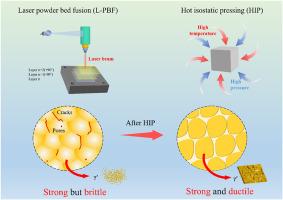Laser powder bed fusion of a Ni3Al-based intermetallic alloy with tailored microstructure and superior mechanical performance
Abstract
Ni3Al-based alloys are excellent candidates for the structural materials used for turbine engines due to their excellent high-temperature properties. This study aims at laser powder bed fusion and post-hot isostatic pressing (HIP) treatment of Ni3Al-based IC-221 M alloy with a high γ′ volume fraction. The as-built samples exhibits unavoidable solidification cracking and ductility dip cracking, and the laser parameter optimization can reduce the crack density to 1.34 mm/mm2. Transmission electron microscope (TEM) analysis reveals ultra-fine nanoscale γ′ phases in the as-built samples due to the high cooling rate during rapid solidification. After HIP treatment, a fully dense structure without cracking defects is achieved, which exhibits an equiaxed structure with grain size ∼120–180 μm and irregularly shaped γ′ precipitates ∼1–3 μm with a prominently high fraction of 86%. The room-temperature tensile test of as-built samples shows a high ultimate tensile strength (σUTS) of 1039.7 MPa and low fracture elongation of 6.4%. After HIP treatment, a significant improvement in ductility (15.7%) and a slight loss of strength (σUTS of 831.7 MPa) are obtained by eliminating the crack defects. Both the as-built and HIP samples exhibit retained high σUTS values of 589.8 MPa and 786.2 MPa, respectively, at 900 °C. The HIP samples exhibita slight decrease in ductility to ∼12.9%, indicating excellent high-temperature mechanical performance. Moreover, the abnormal increase in strength and decrease in ductility suggest the critical role of a high γ′ fraction in cracking formation. The intrinsic heat treatment during repeating thermal cycles can induce brittleness and trigger cracking initiation in the heat-affected zone with notable deteriorating ductility. The results indicate that the combination of LPBF and HIP can effectively reduce the crack density and enhance the mechanical properties of Ni3Al-based alloy, making it a promising material for high-temperature applications.


 求助内容:
求助内容: 应助结果提醒方式:
应助结果提醒方式:


